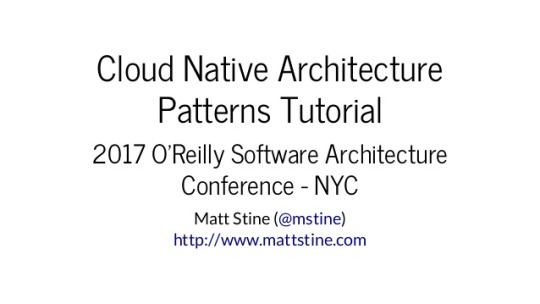#cloud_native
Explore tagged Tumblr posts
Link
Over the last five years, a massive shift in how applications get deployed has occurred. It’s gone from self-hosted infrastructure to the world of the cloud and Kubernetes clusters. This change in deployment practices brought a lot of new things to the world of developers, including containers, cloud provider configuration, container orchestration, and more. There’s been a shift from coding monoliths towards cloud-native applications consisting of multiple microservices.
1 note
·
View note
Photo

: via Pocket https://ift.tt/2NZxOQc
0 notes
Text
VMware Acquires Cloud Native Platform - Pivotal
#VMware Acquires #Cloud_Native Platform - #Pivotal
VMware, Inc. (NYSE: VMW), announced it has completed the acquisition of Pivotal Software, Inc. (“Pivotal”), a leading cloud-native platform provider. As a result of the completion of the acquisition, Pivotal’s Class A common stock was removed from listing on the New York Stock Exchange with trading suspended prior to the open of the market today, and Pivotal will now operate as a wholly owned…
View On WordPress
0 notes
Link
Recently, the Dapr maintainers released V1.10 of Distributed Application Runtime (Dapr), a developer framework for building cloud-native applications, making it easier to run multiple microservices on Kubernetes and interact with external state stores/databases, secret stores, pub/sub-brokers, and other cloud services and self-hosted solutions.
0 notes
Link
Platform engineering is a discipline focused on developing and maintaining software platforms. These platforms are typically core infrastructure components used by applications and services to provide features such as data storage, messaging, authentication, and logging. Platform engineers are responsible for designing, building, securing, deploying, and managing these platforms.
#Platform_Engineering#Platform_Engineer#devops#cloud_native#software#development#Developer_Experience
0 notes
Link
Yet another framework for JVM! Kalix is a new framework for building cloud-native microservices and APIs introduced by Lightbend (the company behind the Scala programming language). Kalix recently provided a new SDK for the Spring framework, allowing developers with experience with Spring Boot to work with Kalix more easily.
0 notes
Link
Kubernetes is an open-source container orchestration system for automating containerized applications' deployment, scaling, and management. It can manage a cluster of virtual machines and other computing resources. OpenShift is a container application platform based on Kubernetes and is used to develop, deploy, and manage applications. It provides an integrated environment for developing, deploying, and managing applications in a cloud-native fashion. In addition, OpenShift offers additional features over Kubernetes, such as application templates, a web console, and a web-based IDE. This article will show you the main differences between these two.
0 notes
Link
This article explores new areas where declarative APIs like Kubernetes and complementary developer tools like Dapr are gaining popularity and becoming mainstream. Dapr is a complementary open-source tool to Kubernetes. It is a developer-centric distributed application runtime that enables developers to write applications and services in any programming language. Dapr provides a set of building blocks that enable developers to build distributed applications quickly, without having to worry about the infrastructure. Both Kubernetes and Dapr provide declarative APIs that make it easier for developers to build and manage applications. This has led to a new set of tools that are gaining popularity, such as Helm, Kustomize, and Draft. These tools allow developers to package their applications into reusable components and deploy them quickly and easily.
0 notes
Link
We've all heard of Kubernetes and its capabilities. We've seen the benefits of it firsthand, but how can you get up and running with Kubernetes quickly? This demo has a web app and database configured with two Pods. One Pod running the database and one Pod running the web app.
0 notes
Photo

5 principles for cloud-native architecture—what it is and how to master it: At Google Cloud, we often throw around the term ‘cloud-native architecture’ as the desired end goal for applications that you migrate or build on Google Cloud Platform (GCP). But what exactly do we mean by cloud-native? More to the point, how do you go about designing such a system? via Pocket http://bit.ly/2ITDJAx
0 notes
Photo

Elastic Cloud Infrastructure: Scaling and Automation en Español: THIS TERMS OF SERVICE AGREEMENT (THE “AGREEMENT”), ALONG WITH THE PRIVACY POLICY LOCATED AT qwiklab.com/privacy_policy (THE “PRIVACY POLICY”), ESTABLISHES THE TERMS AND CONDITIONS APPLICABLE TO YOUR USE OF THE SERVICE (AS DEFINED BELOW) OFFERED BY CLOUD VLAB INC. via Pocket http://bit.ly/2GCdU8c
0 notes
Photo

SnapRoute cloud NOS leans on Kubernetes for orchestration: SnapRoute has embedded Kubernetes in CN-NOS, so DevOps teams can use it to orchestrate the operating system's many containerized network components and synchronize them with compute and storage. via Pocket https://ift.tt/2Stv8HD
0 notes
Photo

Container security vulnerability prompts call to patch runC: The runC utility is core to most container runtimes, so it will take some time and planning to deploy patches for large environments. via Pocket https://ift.tt/2tDPLXD
0 notes
Photo

Closing Out 2018 With A Top-Notch Cloud Native Community Event!: With KubeCon Seattle now behind us, here’s a snapshot of all the cloud native goodness at our most jam-packed show to date. via Pocket http://bit.ly/2MJa26B
0 notes
Photo

Cloud Native Architecture Patterns Tutorial: Upcoming SlideShare Loading in …5 × Cloud Native Architecture Patterns Tutorial 1. Cloud Native Architecture Patterns Tutorial 2017 O'Reilly Software Architecture Conference - NYC Matt Stine ( )@mstine http://bit.ly/2lIFB69 2. Introduction 3. via Pocket http://bit.ly/2Clbyak
0 notes